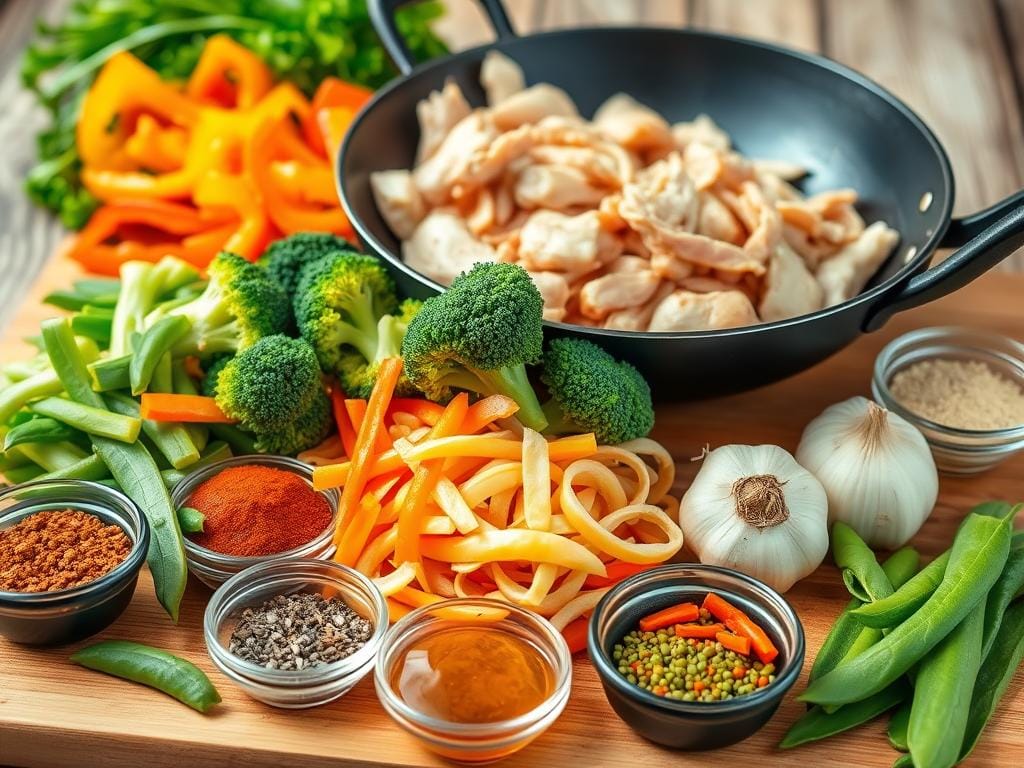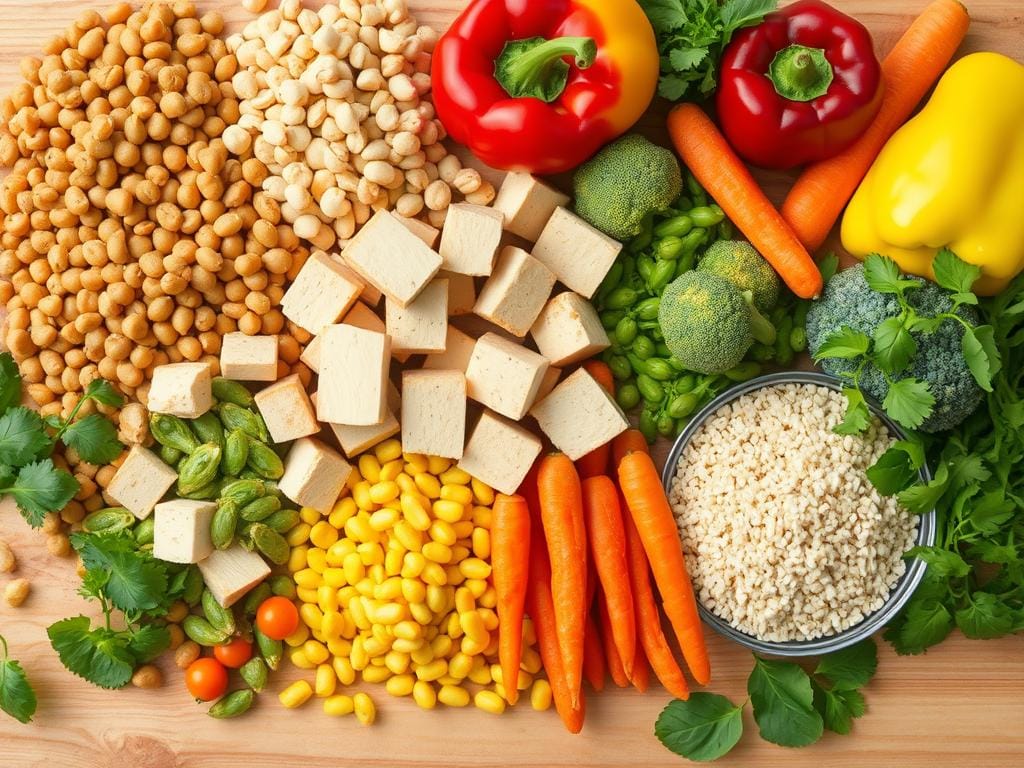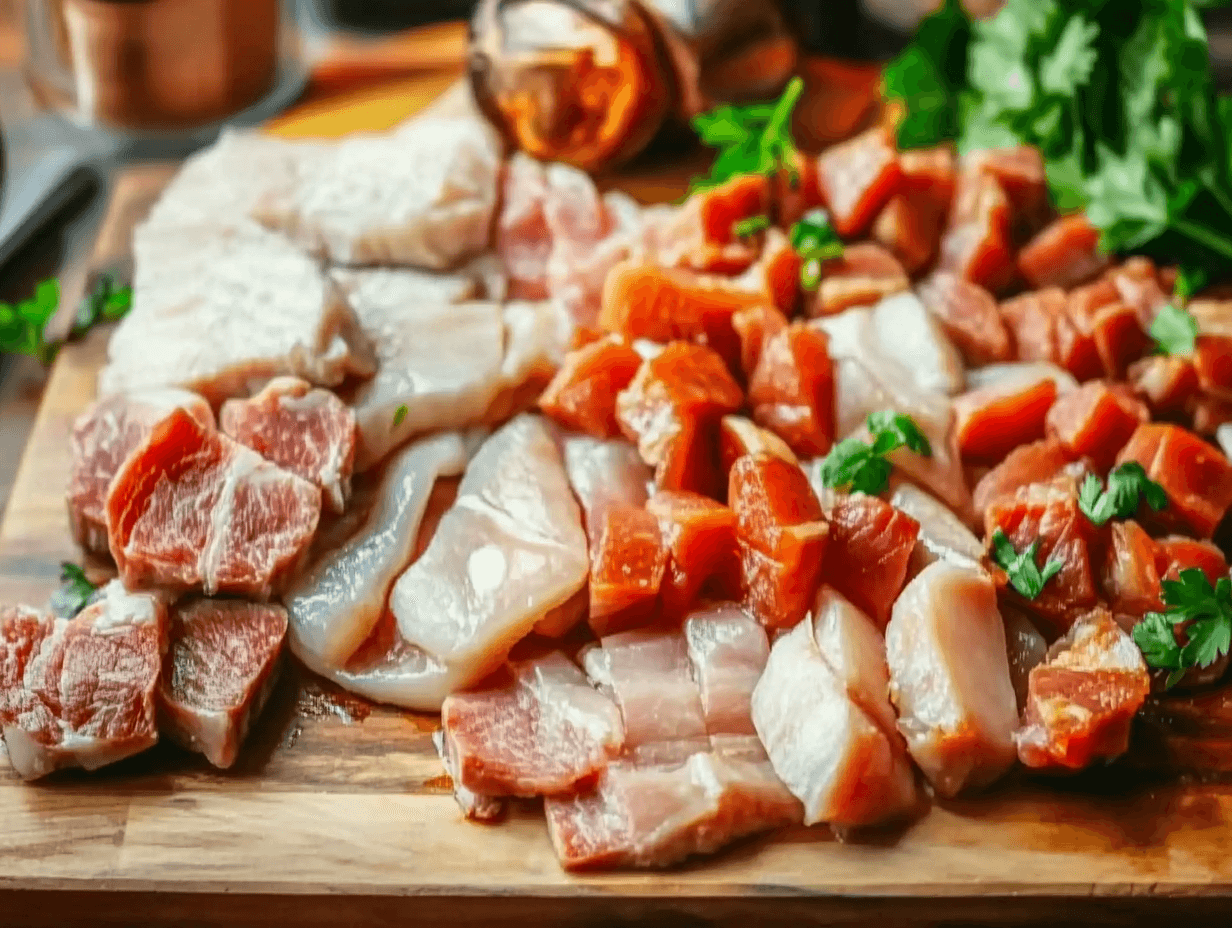I absolutely love cooking and immersing myself in the vibrant flavors of Asian cuisine. From the sizzling stir-fries of China to the aromatic curries of Thailand, choosing the right meat can truly elevate your dishes. Are you wondering what the best meat for Asian food might be? In this guide, I’ll walk you through the top options to enhance your Asian cooking experience.
Whether you’re a pro chef or just starting, you’ll find the perfect meats for many dishes. We’ll look at different cuts, the versatility of chicken and pork, and how to use seafood and organ meats. Get ready to improve your cooking and wow your loved ones with delicious Asian dishes.
Table of contents
Key Takeaways
- Discover the best cuts of beef, pork, chicken, and seafood for authentic Asian cuisine
- Learn how to prepare and cook different meats for optimal texture and flavor in stir-fries, curries, and more
- Explore the versatility of proteins like chicken and pork in a variety of Asian dishes
- Understand the importance of proper meat preparation, including marinating techniques and ideal cooking methods
- Uncover the secrets of incorporating seafood and organ meats into your Asian culinary creations
Understanding the Different Asian Cuisines
Asian cuisine is celebrated for its incredible range of flavors and ingredients. For example, from China’s aromatic stir-fries to Japan’s delicate sashimi, each region showcases its own unique cooking techniques. Together, these culinary traditions highlight the remarkable diversity of meats used in Asian cuisine.
Chinese Cuisine: Popular Meats and Cuts
Chinese food often includes beef, pork, and chicken in stir-fries, braises, and slow-cooked dishes. Favorites are thinly sliced flank steak, tender pork shoulder, and juicy chicken thighs. They are seasoned well and cooked just right.
Japanese Cuisine: Unique Meat Choices
In Japan, the focus is on high-quality, often rare, proteins. Wagyu beef is loved for its marbled texture and rich taste. Seafood like tuna, salmon, and octopus are also celebrated in sushi and sashimi.
Thai Cuisine: Flavorful Proteins
Thai dishes are renowned for their bold and fragrant flavors. For instance, chicken, pork, and seafood are commonly featured in a variety of dishes, including curries, stir-fries, and soups. Additionally, ingredients like lemongrass, galangal, and kaffir lime leaves infuse these proteins with a distinctive and irresistible aroma, making Thai cuisine truly unique.
Each Asian culinary tradition has its own meat preferences and cooking methods. This leads to a wide variety of delicious flavors. Knowing these differences helps you choose the best meats for your Asian dishes.

Slow Cooking Inspirations
For slow-cooked curries or braised meats:
- Beef: Opt for brisket or chuck, which tenderize over time.
- Lamb: Shoulder and leg cuts are perfect for rich, slow-cooked dishes.
- Chicken: Thigh meat stays juicy and flavorful during long cooking processes.
For inspiration, check out these flavor-packed chicken recipes.
Slow cooking opens up a world of flavors and tender textures in Asian-inspired cuisine. It’s perfect for making hearty beef curry or flavorful lamb dishes. The right cuts of Asian cuisine meats are key to creating delicious slow-cooked meals.
Ideal Meats for Slow-Cooked Curries
For slow-cooked curries, use tougher cuts of beef like chuck or brisket. These cuts become tender and soak up all the flavors of spices and aromatics during long cooking times.
Recipes Using Lamb for Asian Flavors
Lamb shoulder or leg is great for Asian-inspired slow-cooked dishes. It offers a robust flavor that goes well with bold spices and sauces. Slow cooking makes the lamb tender and luxurious.
Cooking Tips for Tender Chicken for Asian Recipes
When it comes to slow-cooked poultry, chicken thighs are undoubtedly the best choice. Not only do they stay moist and flavorful during extended cooking, but the slow heat also enhances their natural richness. This method perfectly complements other ingredients, creating a harmonious and delicious dish.
Slow cooking is perfect for tender, fall-off-the-bone meats in Asian dishes. By choosing the right cuts and techniques, you can make amazing slow-cooked meals. These dishes will impress your taste buds and satisfy your cravings.
Essential Seafood Choices
Seafood is key in Asian cuisine, adding delicious flavors to dishes. Salmon, tuna, and white fish are just a few options. Look for clear eyes, firm flesh, and a fresh smell to ensure freshness.
Seafood is vital in Asian dishes:
- Best Choices: Salmon, snapper, and shrimp work well in stir-fries or soups.
- Tips for Freshness: Look for firm flesh and a clean, ocean-like scent.
If you’re exploring seafood options, try these elegant seafood recipes for gourmet ideas.
Best Seafood Options for Asian Recipes
Popular seafood choices in Asian cuisine include:
- Salmon
- Tuna
- Cod
- Halibut
- Tilapia
- Snapper
How to Select and Prepare Fresh Fish
Choose fish with clear eyes, firm flesh, and a fresh smell. Avoid dull or smelly fish. Clean and prepare fish well for the best taste and safety.
Incorporating Shellfish into Dishes
Shellfish like shrimp, crab, and scallops add sweetness and texture to dishes. Clean and prepare them well to enhance their flavors. Quick cooking methods like steaming or stir-frying work best.
Using a variety of seafood in your Asian recipes makes dishes tasty and beautiful. Whether it’s a stir-fry or something new, seafood is a must in Asian cuisine meats.
Organ Meats: A Delicacy in Asian Cuisine
In many Asian cuisines, organ meats, or offal, are seen as special treats. They offer rich, earthy flavors and unique textures. Learning how to prepare each type is key to enjoying their full taste in your dishes.
Understanding the Use of Offal
Organ meats have been a big part of traditional Asian cooking for a long time. They are loved for their strong flavors and health benefits. In Chinese cooking, liver, heart, and kidney are favorites. Japanese chefs often use yakitori (skewered grilled offal) in their menus.
Thai and Vietnamese dishes might include nám (fermented pork offal) or hủ tiếu (a noodle soup with organ meats).
Popular Organ Meats in Different Cuisines
- Chinese Cuisine: Liver, heart, kidney, and tripe are all commonly used in stir-fries, braises, and soups.
- Japanese Cuisine: Yakitori featuring skewered liver, heart, and other offal is a beloved izakaya (Japanese pub) staple.
- Thai Cuisine: Dishes like nam tok moo (spicy grilled pork salad with liver) and larb (spicy minced meat salad) often incorporate organ meats.
- Vietnamese Cuisine: Fermented pork offal known as nám is a key ingredient in dishes like hủ tiếu (noodle soup) and chả lụa (Vietnamese pork sausage).
By learning about the unique qualities and cooking methods of these Asian cuisine meats, you can take your cooking to the next level. Whether you’re making a classic stir-fry or trying out new What is the best meat for Asian food? recipes, adding offal can make your dishes more delicious and healthy.
Exploring Plant-Based Proteins
In Asian cuisine, plant-based proteins play a crucial role, offering tasty and flexible options. Tofu and tempeh, for instance, stand out for their ability to blend seamlessly into many dishes.
Tofu: Versatile and Flavorful
A staple of Asian cooking for over 2,000 years, tofu is a soy-based product with a variety of textures, ranging from soft to firm. This versatility makes it ideal for countless recipes.
Its ability to soak up flavors makes tofu great for Asian cuisine meats stir-fries, soups, and braises. It takes on the taste of the dish it’s in.
Tempeh as a Protein Alternative
Tempeh, a fermented soybean product from Indonesia, is also popular. It has a nutty taste and a firm texture. This makes it a good meat substitute in many Asian dishes.
Whether grilled, stir-fried, or in curries, tempeh is a healthy Asian cuisine meats choice. It’s a great option for those looking for sustainable and nutritious food.
Plant-based proteins like tofu and tempeh open up many culinary doors. They also meet the need for What is the best meat for Asian food? sustainable and healthy eating. As the world’s population grows, these alternatives will be key to feeding everyone.

Regional Meats to Consider
Exploring Asian cuisine meats means looking beyond the usual choices. Discovering unique regional meats can make your dishes stand out. Try game meats like venison and wild boar, or specialty meats like water buffalo and yak. These offer a wide range of flavors and textures that bring Asian cultures to life in your kitchen.
Game Meats in Asian Cooking
Meats like venison, wild boar, and duck are loved in many Asian dishes. They have deep flavors and tender textures. To get the most out of them, you need to use special cooking methods. Adding game meats to your Asian cuisine meats can make your dishes unique and exciting.
Specialty Meats Unique to Specific Regions
Some Asian regions have their own special meats. For example, water buffalo is common in Southeast Asia, while yak is found in Tibetan and high-altitude areas. These meats add unique tastes and textures to traditional dishes. Learning about their cultural importance and how they’re prepared can deepen your appreciation for what is the best meat for Asian food.
Trying different regional meats in your Asian cuisine meats journey can lead to new flavors and cultural insights. By learning about these special proteins and their uses, you can gain a deeper appreciation for Asian culinary traditions.
Flavoring Meats for Authentic Dishes
Marinades and sauces are essential for enhancing Asian dishes. Incorporate ingredients like soy sauce, ginger, garlic, and spices to maximize flavor. For sauces to pair with meats, try these homemade sauce recipes.
What is the Best Meat for Asian Food? Marinades and Sauces for Enhanced Flavor
What is the best meat for Asian food? The answer often depends on the dish and preparation style, but the secret to elevating any meat in Asian cuisine lies in marinades and sauces. Marinades form the foundation of many Asian meat dishes, infusing proteins with bold and aromatic flavors.
Common ingredients like soy sauce, garlic, ginger, and a variety of spices not only season the meat but also tenderize it. For beef, a rich marinade of soy sauce and brown sugar adds a sweet and savory, caramelized finish. If you’re preparing chicken for Asian dishes, lighter marinades featuring lemongrass or citrus help to keep the meat moist, tender, and flavorful.
What is the Best Meat for Asian Food? Spices to Pair with Different Meats
Spices are essential in answering what is the best meat for Asian food, as they add depth and authenticity to every bite. For beef, consider robust spices like star anise, cinnamon, and Sichuan peppercorns. These fragrant spices enhance the bold, meaty flavors typical of Asian dishes.
On the other hand, when working with chicken in Asian recipes, delicate spices such as cardamom, fennel, and white pepper complement the natural sweetness of the poultry. Each spice combination creates unique layers of flavor that make the meat stand out in the dish.
Master the Art of Marination
Proper marinating techniques are critical when determining what is the best meat for Asian food. Marination allows the meat to absorb a symphony of spices and seasonings, bringing out the signature flavors of Asian cuisine. Whether you’re experimenting with beef, chicken, or other proteins, finding the perfect marinade and spice blend will elevate your dish and bring the vibrant tastes of the East to your table.
Final Thoughts on Selecting the Best Meats for Asian Food
Choosing the right meat is key to making tasty Asian dishes. Look for fresh, authentic cuts at reputable butchers or Asian markets. Whether it’s a stir-fry, curry, or hot pot, the right meat makes a big difference.
Sourcing Quality Meats for Your Dishes
Check out local suppliers for a wide range of Asian meats. You’ll find everything from beef and pork to lamb and game meats. Talk to the staff to get the best cuts and cooking tips.
Balancing Health and Flavor in Your Choices
Find a balance between healthy and tasty in your cooking. Rich, fatty meats are delicious, but leaner options and plants are healthy and tasty too. Try different cooking methods and sauces to find your favorite flavors.
By understanding and selecting the best meats for your Asian dishes, you can elevate your cooking and delight your taste buds. Whether it’s tender beef for a stir-fry or fresh seafood for a soup, knowing what is the best meat for Asian food makes all the difference.
FAQ
What Meat Do Asians Eat Most?
The most commonly consumed meats in Asian cuisine include pork, chicken, and beef, although the preference varies by region:
- Pork – This is the most popular meat in East Asia, especially in countries like China, Vietnam, and Korea. It is used in dishes such as sweet and sour pork, dumplings, and barbecued pork (char siu).
- Chicken – Widely consumed across Asia, chicken is used in dishes like chicken curry (India), Hainanese chicken rice (China/Singapore), and tandoori chicken.
- Beef – While less common in some areas (e.g., India, where cows are sacred), beef is essential in Korean barbecue, Japanese yakiniku, and Vietnamese pho.
- Lamb/Mutton – Common in Central Asia and parts of India and Pakistan, where lamb curry, kebabs, and biryanis are popular.
- Seafood – Coastal regions, such as Japan, Southeast Asia, and South China, rely heavily on fish, shrimp, and shellfish.
What Are the Best Beef Cuts for Asian Dishes?
The best beef cuts for Asian cooking are those that offer tenderness and absorb marinades well:
- Short Rib – Popular in Korean barbecue (galbi) due to its tenderness and marbling.
- Flank Steak – Ideal for stir-fries and dishes like beef chow fun or Vietnamese pho because it cooks quickly and remains tender when sliced thin.
- Brisket – Used in slow-cooked Asian dishes such as Chinese braised beef brisket and Vietnamese pho broth.
- Ribeye – Common in Japanese shabu-shabu (hot pot) and Korean barbecue due to its marbling and rich flavor.
- Sirloin – Affordable and versatile for stir-frying or grilling in various Asian dishes.
What Is the Best Cut of Meat for Stir-Fry?
For stir-frying, the best cuts of meat are tender and lean so they cook quickly and stay juicy. These include:
- Beef: Flank steak, sirloin, or skirt steak – These cuts are flavorful and easy to slice thinly.
- Pork: Pork loin or tenderloin – They are lean and cook quickly in stir-fried dishes.
- Chicken: Chicken breast or thighs – While thighs are juicier, breasts are leaner and absorb sauces well.
- Lamb: Leg or shoulder cuts – Thin slices of lamb are excellent for quick stir-fries.
Pro Tip: Always slice the meat against the grain and marinate it briefly to tenderize it further.
What Meat Is Used for Chinese Food?
Chinese cuisine incorporates a wide range of meats, with the most popular being:
- Pork – The most widely consumed meat in China, used in dishes like sweet and sour pork, char siu (barbecued pork), and dumplings.
- Chicken – Common in stir-fries, soups, and steamed dishes, such as Kung Pao chicken and white cut chicken.
- Beef – Used in dishes like beef with broccoli, braised beef, and noodle dishes like beef chow fun.
- Duck – Peking duck is a famous Chinese delicacy.
- Lamb/Mutton – Popular in northern China and regions like Xinjiang, often in skewers or hearty stews.
- Seafood – Fish, shrimp, crab, and shellfish are central in coastal regions, often steamed, stir-fried, or served in soups.
Chinese cooking makes extensive use of marinades, sauces (like soy sauce and oyster sauce), and cooking methods (stir-frying, steaming, and braising) to maximize flavor and tenderness.
By using high-quality meats and trying out versatile dishes, you can master Asian cuisine at home. For a deeper dive into stir-fry flavors, explore this quick and easy shrimp stir-fry. Enjoy cooking!

